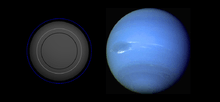Gliese 581b
Gliese 581b or Gl 581b is an extrasolar planet orbiting within the Gliese 581 system. It is the first planet of three discovered in the system so far, and the second in order from the star.[2][3]
 Size comparison of Gliese 581 b with Neptune. (Based on selected hypothetical modeled compositions) | |
| Discovery | |
|---|---|
| Discovered by | X. Bonfils, T. Forveille, X. Delfosse, S. Udry, M. Mayor, C. Perrier, F. Bouchy, F. Pepe, D. Queloz, J.-L. Bertaux |
| Discovery date | August 22, 2005 announced November 30, 2005 |
| Doppler Spectroscopy | |
| Orbital characteristics | |
| 0.04061 ± 0.0001 AU (6,075,000 ± 15,000 km)[1] | |
| Eccentricity | 0.00 ± 0.03[1] |
| 5.3686 ± 0.0001[1] d | |
| 2454751.76 ± 0.01[1] | |
| Semi-amplitude | 12.6 ± 0.2[1] |
| Star | Gliese 581 |
Discovery
The planet was discovered by a team of French and Swiss astronomers, who announced their findings on November 30, 2005, as a discovery of one of the smallest extrasolar planets ever found, with one conclusion being that planets may be more common around the smallest stars. It was the fifth planet found around a red dwarf star (after Gliese 876's planets and Gliese 436 b).
The planet was discovered using the HARPS instrument, with which they found the host star to have a wobble that implied the existence of the planet.
The astronomers published their results in Astronomy and Astrophysics Letters.[4]
Orbit and mass
Gliese 581b is at a minimum, approximately 15.8 times the Earth's mass, similar to Neptune's mass. It does not transit its star, implying that its inclination is less than 88.1 degrees.[5] It is rather close to Gliese 581 and completes a full orbit in only 5.4 days at a mean distance of about 6 million kilometers (0.041 AU). By comparison, Mercury is at a distance of 58 million kilometers (0.387 AU) and completes an orbit in 88 days.
Characteristics
Gliese 581b is about 0.04 AU from its sun. It is likely close to Gliese 436 b in mass, temperature, and (with Gliese 876 d) susceptibility to solar effects such as coronal mass ejection. Gliese 581b does not transit. At the least, given that Gliese 581b orbits alongside two other planets (Gliese 581c and e) and that Gliese 436 b (thus far) stands alone, their formation must have differed.
See also
References
- Robertson, Paul; Mahadevan, Suvrath; Endl, Michael; Roy, Arpita (3 July 2014). "Stellar activity masquerading as planets in the habitable zone of the M dwarf Gliese 581". Science. 345: 440–444. arXiv:1407.1049. Bibcode:2014Sci...345..440R. doi:10.1126/science.1253253. PMID 24993348.
- "Gl 581 b". Archived from the original on 2014-02-10.
- "If There's Life on Alien Planet Gliese 581g, How Do We Find It?".
- X. Bonfils; et al. (2005). "The HARPS search for southern extra-solar planets VI: A Neptune-mass planet around the nearby M dwarf Gl 581". Astronomy and Astrophysics Letters. 443 (3): L15–L18. arXiv:astro-ph/0509211. Bibcode:2005A&A...443L..15B. doi:10.1051/0004-6361:200500193.
- M. Lopez-Morales; et al. (2006). "Limits to Transits of the Neptune-mass planet orbiting Gl 581". Publications of the Astronomical Society of the Pacific. 118 (849): 1506–1509. arXiv:astro-ph/0609255. Bibcode:2006PASP..118.1506L. doi:10.1086/508904.
External links
| Wikimedia Commons has media related to Gliese 581 b. |